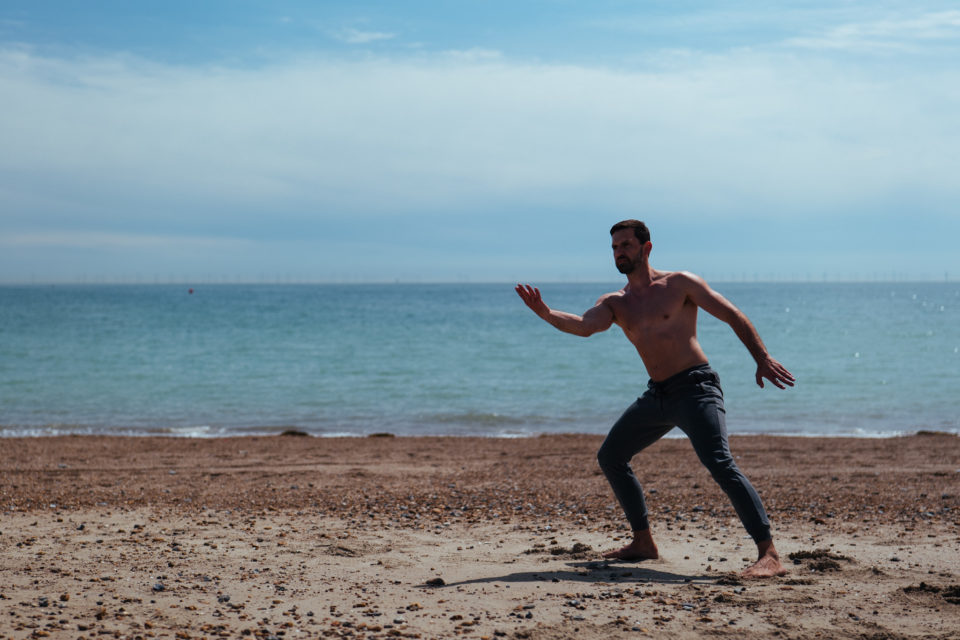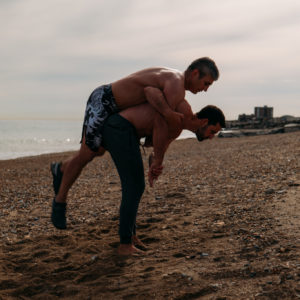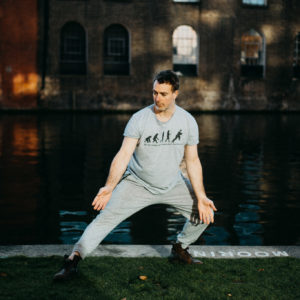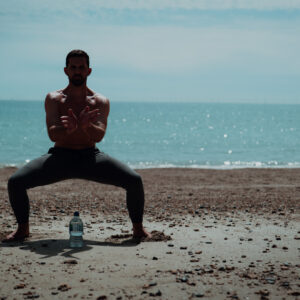Traditional Tai Chi training consists of many fascinating and enjoyable practices which can benefit you in a variety of ways. There are a lot of different approaches to practicing this art, with many different styles available, each one with their own approach to practicing. The benefits you can get from Tai Chi are very much determined by the style and teachings offered. In this article I’ll look at the benefits of ‘Wudang’ style of Tai Chi, as this is the one I practice and know most about.
In a nutshell, the 9 major benefits of Tai Chi training can be seen as;
- Community
- Cardiovascular health
- Weight management
- Flexibility
- Strength and power
- Posture, balance and movement skill
- Stress & anxiety reduction and mind state improvement
- Confidence
- Self defence
So let’s go through each one, in a lightly different order, and learn about why they are very worthwhile side effects of the overall Tai Chi training process.
Tai chi benefit 1. Posture, balance and movement skill
Tai chi training is essentially all about training movement. The older classical texts written by the original masters of the art discuss the idea of learning to move with profound levels of awareness. Beginners are often uncoordinated and their ability to feel and control their bodies’ is limited. With practice, this is improved upon and as development continues, Tai Chi practitioners are urged to refine their movement skills until they are focussing ‘from yards, then to feet, then to inches, then to hundredth parts, then thousandth parts’.
As you develop your ability to improve your body awareness, you are encouraged to feel this happening on an ever more subtle level, until you are aware of details that may not be visible externally.
Developing the ‘Tai chi posture’ requires perfect awareness and re-alignment of the spine. It requires the ability to become aware of and then release physical tensions throughout the body. A properly aligned body will allow the various internal communication systems (such as the nervous system) to function more efficiently, providing a better communication to and from the vital organs of the body. this will lead to better overall health and vitality.
Having a positive body posture is now known to have positive effects on hormonal levels, and can impact things like positive or negative emotional recall. So simply improving your day to day posture can have a huge effect on improving how you feel and how you interact with the world, as well as others perception of you.
From a martial arts perspective having complete control over your body, your balance and being able to move with precision and perfect timing increases your potential effectiveness in all ways. Having a more positive body posture, and overall control of your body is even helpful in terms of preventing you being seen as ‘fair game’ by predatory attackers. This has been studied in various trials on inmates, to see who they would target as a victim – those with weak body posture were seen as good prey.
For the elderly the gentler aspects of Tai Chi such as the hand form, can be an extremely effective exercise that will help them improve and maintain a good level of balance and coordination that’ll prevent them from falling, which is a significant hazard for many.
So overall just learning to align your body correctly, relax and learn to move well in a coordinated way can have many significant benefits.
Tai Chi benefit 2. Flexibility
Flexibility is very much tied into the previous benefit and the ability to hold good posture and to move well in all ways. Tai Chi has a very systematic approach to stretching the body in all the major and minor ways that a human body should be able to move without restrictions.
The Tai Chi foundation paradigm of yin and yang works within the realm of improving flexibility too. There are benefits to be had from static ‘yin’ style stretching, as well as more dynamic moving stretches (yang). Spinal flexibility in bending forward and backwards (flexion/extension) as well as in rotation is give primarily importance. The spine is seen as a ‘root of life’, as the nervous systems’ superhighway, and so it should be kept in it’s optimal condition.
Hip flexibility is trained and developed in movements such as ‘snake creeps down’. Hip flexibility and flexibility of the ankles is often a restricted areas for many of us in the west, probably due to excessive used of sitting, rather than the deep squatting postures of our ancestors.
Tai Chi neigong training is one of the primary ways we develop flexibility in all the key movement patterns of the body, gently loosening any restricted or tight areas through dozens, or even hundreds of controlled and felt movements.
Tai Chi benefit 3. Cardiovascular health
Did you know that the fitness variable VO2max is the one most closely correlated to life expectancy? Out of all the fitness training variables improving our VO2 max might be the best thing we can do to improve our health.
Essentially this means how well our heart works to deliver oxygenated blood to the various parts of the body that need it. This is often referred to as ‘central’ cardiovascular function. The ability of the muscles to uptake and use the circulating oxygen is referred to as ‘peripheral’ endurance.
VO2max is known to respond very well to both steady state, rhythmic, whole body movements that are sustained over time. It also responds very well to higher intensity, shorter duration ‘intervals’ – which is why the HIIT craze has gained popularity.
Tai Chi can improve your cardiovascular health and fitness in various ways. Even the slow motion movements of the long form have been well studied and research shows statistically significant improvements in VO2max from practice. This is often counter intuitive for many people who think ‘cardio’ training has to involved running, cycling etc. The Tai Chi long form is a weight bearing exercise, which can be modified to increase or decrease exercise intensity as required. As you move around from posture to posture, the large muscles of the legs, and trunk, as well as shoulders and arms have to work pretty hard to control the movements. This puts a metabolic demand on your body which your heart will adapt to.
Pushing hands footwork drills, such as nine balance step, gather the wave, seven star step and Da Lu all feature low postures, and repetitive and rhythmic whole body movements. These drill place significant demand on the bodies metabolism, and your heart function will up-regulate quickly. These drills are often done for 15-40 minutes each and when done properly are easily equivalent to going for a good run.
In our system of Tai Chi we use practice the original conditioning methods which are designed for Tai Chi fighters to achieve peak fitness for full contact fighting. These methods are high intensity interval training techniques, which are extremely demanding and can take your cardiovascular fitness to very advanced levels.
Tai Chi Mechanotransduction and peripheral factors of cardiovascular health
The bodies’ capilliary system is extremely dense, with most cells of your body being within fifty micrometers of a capilliary. The mechanical stimulation of your working muscles is required to pull blood from the arteries into the working muscles. So your working muscles pull the blood to the tissues that need it, and which have been stimulated by exercise.
So cardiovascular health requires not only an efficient pump to provide the initial push of blood, but we should also be feeding as many of our cells by making the tissues work and pull blood into those areas. Your cells require regular oxygenation to maintain optimal health. This has been coined by some researchers as ‘cellular nutrition’.
Tai Chi (particularly repetitive neigong movements) systematically move the 600 skeletal muscles of the entire body, so that it is thouroughly nourished and oxygenated.
Tai Chi benefit 4. Strength and Power
Traditional Tai Chi Chuan, practiced as a martial art, is designed to make you extremely physically strong and powerful. Those practitioners who practice only the softer ‘yin aspects’ such as the long form, will certainly increase their strength, but only to a certain degree.
Martial Tai Chi practice begins the process by significantly increasing the strength of the legs, the muscles that support the spinal column (back/core/abs) and the muscles that stabilise the shoulders. As training develops the arms, forearms and fingers are developed in a systematic way.
Tai Chi seeks a balanced development of the body, so that your physique remains proportional and well balanced. Strength increases come from both development of the physical muscles and also the ability of your nervous system to use and contract them. Skilful use of strength, along all possible movement patterns is called ‘Jin’ in Tai Chi, which is the idea of trained and refined strength, rather than brute strength/ clumsy strength.
Once the body is well developed and you are skilful in the application of strength (via nervous system control) then power is worked on. In Tai Chi we call it ‘Fa Jin’ or the ability to explosively express trained force (Jin). There’s a lot of misinformation on Fa Jin in the Tai Chi world, but essentially it requires the ability to completely relax your muscles (reducing inhibiting muscle activity) as well as the ability to recruit your muscles very quickly into their movement job. There are additional factors such as being able to store and utilise the elastic properties of connections give tissues, but these are beyond the scope of this article.
Suffice to say, that as a well trained Tai chi practitioner, you will become very strong and physically powerful in a vary flexible and functional way.
Tai Chi benefit 5. Weight loss and management
Maintaining a healthy and appropriate bodyweight is a difficult challenge in todays sedentary society. Endless possibilities for eating all kinds of food, our minds being bombarded with food imagery all the time and the quality of food being generally very poor and contaminated make it difficult for people to stay ‘in shape’.
Tai Chi can help you in a variety of common sense ways, to keep a good looking and healthy physique.
Many people acquire terrible nutrition habits simply because of the society we live in and the adoption of new norms when it comes to food and drink. We have been duped into eating all kinds of fast foods, and heavily processed, cheap to produce nonsense, which wreaks havoc on our internal systems and biology.
Tai Chi at it’s core espouses a philosophy of awareness, so the first thing you will notice is that when you become a committed practitioner you tend to become more aware and ‘mindful’ of the food and drink choices you are making. This is a first significant step to improving your physical condition, aesthetically and from a health perspective.
Tai Chi provides you with significant practices, which are mechanically and calorifically demanding. An hour of long form practice is equivalent to the calorie expenditure of a similar amount of medium intensity cycling for example. All the different aspects of the art put on a good mechanical load, requiring your body to expend significant amount of calories. As a good practitioner hopefully you’ll be moving your body in various ways for at least an hour a day (can be a lot more for advanced people) – and so creating a good opportunity to create a calorie balance/deficit there.
Many people make poor food choices and overeat/drink because of excessively high levels of stress, which is shown in research to lead to weight gain. Additionally when you are in a stressed out state your body will naturally make you fatter and store fat. This fat will then produce more stress hormones and so it starts a viscous cycle.
Tai Chi helps you to combat and reduce stress in a very wide variety of ways which we will explore further on. All you need to know at this stage is that by practicing Tai Chi, you will reduce your stress levels, rebalance your hormones and be better able to make healthier choices and reduce cravings. Your rebalanced hormones will naturally encourage your body to ‘let go’ of stored fat and then you will move into a more positive cycle.
At it’s core Tai Chi is a Taoist derived art and activity. The Taoists understood that as humans we are a little piece of the cyclical processes in the universe. As such we need to act in accordance with and not go against the simple, obvious and yet often times contravened natural laws. They put a huge emphasis on the importance of adhering to a wholesome and natural diet, devoid of any refined ingredients.
As a Tai Chi practitioner, you may naturally become interested in adopting these types of naturalistic living philosophies, as they are fundamental to the whole Tai Chi concept. You may also start to address other lifestyle imbalances, such as sleep/wake habits. The Taoists were advocated of being in harmony with these cycles and sleeping and rising with the movements of the sun. This is now known by good science to have huge impacts oral aspects of our health, in particular our hormonal profiles. These in turn contribute strongly to weight gain, or sub-optimal body composition. So starting to live the naturalistic Tai Chi philosophy can do wonders for your waistline, but also many more serious health related conditions.
The more demanding ‘yang’ aspects of Tai Chi will go a long way to ramping up your metabolism, and will also develop lean muscle tissue. It is known that lean muscle tissue is more metabolically active and needs more calories to sustain it, so your body will burn more energy even at rest.
So there you can see, through lifestyle management, stress reduction and improved metabolism as well as increased calorie expenditure, Tai Chi practice can keep you in excellent physical shape.
Tai Chi benefit 6. Stress & anxiety reduction and mind state improvement
All aspects of Tai Chi training are supposed to be carried out with a ‘relaxed attitude’. This means that no matter which aspect you are training you should be pretty chilled out. This is coupled with a relaxed and yet enhanced state of awareness of movement and feel. Some people call this the ‘felt sense’.
Tai Chi also recommends in its practitioners an attitude of acceptance and non-judgemental thinking. Essentially moving away from dualistic think and simply observing your practice and letting things be. Some people would call this ‘mindfulness’. These ideas all come from Taoism, whose original primary concern was getting people to live effortlessly and in accordance with their own nature and the nature of the world.
So initially when you begin learning you should start to really work on these attitudinal factors as thy will largely dictate how far you can progress in the art and what benefits you will receive. A lot of psychological research has been done on people which shows that having a primarily ‘task’ related focus rather than ‘outcome or performance’ focus leads to greater potential growth and greater feelings of satisfaction and contentment. The Taoists were definitely right.
Tai chi theory dictates that all breathing should be done through the nose, and that the stomach area should be devoid of tension. These two things, coupled with the emphasis (in some aspects) on slow movements with no unnecessary tension, leads to a sinking of the diaphragm. This sinking action of the diaphragm as you breath not only stimulates the cells of the various internal organs and intestines it also switches the activity of the nervous system from sympathetic, to parasympathetic. This is the ‘rest and digest’ mode for your body, where it reduces heart rate and blood pressure and puts the body into a more restful and relaxed state.
An array of anti-stress hormones prolactin, oxytocin, and vasopressin are released when your parasympathetic nervous system is activated.
As well as being a mindful activity, with the focus of our awareness being on our movements and the feelings of the body, some Tai Chi aspects also include breath awareness meditation. This is another activity which has been shown in scientific research to assist in reducing stress, increasing feelings of optimism and developing a positive mindset. This system of Tai Chi also includes mantra based meditation as part of the Neigong training. Mantra based meditation is also a very well researched, highly effective method of inducing a ‘relaxation response’ as researched by the Herbert Benson of Harvard Medical School.
Another stress busting tool in Tai Chi is the use of standing postures. These come from our Neigong syllabus, and are essentially specially designed postures which are held in a very comfortable way for extended periods of time (up to an hour in some cases). Stillness training was traditionally used by Taoists, to achieve mental tranquility, and standing practices are very effective in putting you in a very calm state, whilst you train your body physically.
So by encouraging healthier and more realistic attitudes via the profound, yet simple of Taoisim Tai chi practice can have a significant role in improving mood, stress levels and feelings of well-being. Combine this with the various stress busting practices and you have a comprehensive approach to improving your overall physiological and psychological state, which are mutually dependant.
Tai Chi benefit 7. Real self defence
This will only apply to a few, select Tai Chi schools that still incorporate a proper Tai Chi self defence program. Unfortunately most no longer have this in their syllabus.
Tai Chi self defence is based on the idea of the ‘Tai Chi principle’ and simplistically means being completely adaptable, spontaneous as well as precise and extremely dangerous. A lot of good training is required to be skilful in self defence (regardless of which ‘style’ is used).
Tai Chi really isn’t a ‘style’, its a concept that has been made physical and martial. Therefore just as there are an infinite ways that you can be attacked, responding in the most spontaneous and intelligent way is the root of the Tai Chi concept. Avoid the strong parts or attacks from the opponent and attack the weak and vital areas using your most powerful and dangerous weaponry. Yin vs Yang and vice versa.
There are no techniques that are Tai Chi specific, all that matters is that it is effective and used well. Footwork and evasive skills are emphasised in defence as these are more effective and can help set up you’re counters. Striking with all parts of the body is trained, and is always aimed at the most vulnerable parts of the attacker. Theres a lot of emphasis on become a very skilful standing up grappler, with throws and sweeps, traps and locks etc.
Techniques are initially learned by rote but need to be developed to a point where you are so familiar with them you can apply them with speed agains full power and speed attacks. Comfort in high stress fighting scenarios is trained for those serious about their martial abilities.
Most ‘Tai Chi fighting’ out there in the wild is absolute drivel. You’ll often see demonstrations of people going flying or bouncing around. This is all (unfortunately) fantasy. Watch any of the Tai Chi vs MMA videos on youtube and you will see hilariously bad examples of this being shown. These Tai Chi practitioners are not training real martial Tai Chi.
The real stuff looks a lot more like MMA (without the groundwork). In the hands of a very skilful practitioner it will look extremely subtle and effortless. It takes time however to acquire real high level fighting skill, as we are dealing with not only striking but also grappling. However you should quite quickly become effective with some solid key fighting/self defence skills in just a few months if you are training seriously.
Having worked as a bouncer for several years and competed at championship level in professional MMA when it first came to the UK I can without hesitation that real Tai Chi can give you unlimited fighting potential when its trained correctly and in a good environment. Many of my students have over the years won a lot of national and international fighting tournaments, which is an extreme testing ground for the practicality of a martial art.
As a bouncer I was often able to effortlessly (well almost) control unruly customers without having to resort to more extreme measures, because of the subtle standing grappling skills the art develops. These days everyone is under the impression that they need to become a ground grappler for self defence, which in my experience is false and dangerous.
So in summary Tai Chi self defence is not what you think, but it is the most conceptually sophisticated model I have come across for dealing with conflict and violence. Our wudang Tai Chi system backs up the conceptual model with an array of practical fighting drills and techniques to make you a formidable opponent whether you are grappling or striking.
Tai Chi benefit 8. Confidence
Your confidence through Tai Chi training can be improved in a multitude of ways. For example your physique is likely to improve which will lead to increased confidence in your appearance. I think that this might also like in nicely with improved postural stance, which definitely improves confidence.
You may feel like you can become more assertive with people as your self defence abilities improve, again improving your feelings of confidence.
As you improve in your practices within the art, this can improve your relationship with self-reliance and ‘self mastery’ both of which are known to increase feelings of well being and confidence.
Tai Chi benefit 9. Community
The irony of the social media and digital age is that people are more than ever reporting feelings of disconnection and isolation. An important aspect of training in a martial arts club that has a good community, is that you will connect with and make friends with like minded people, who are quite likely to have a similar value system to you.
This connection with a community of like minded people has a wide multitude of well researched benefits including importing feelings of purpose, improving various health marker and mood states etc.
So to sum it up
Tai Chi practice can bring you so many benefits that it would be silly not to take it up. Ideally you will find a good class, with an experienced teacher who can teach you the martial aspects too, though even without the more ‘yang’ aspects Tai Chi practice will still give you an incredible amount of benefit. Tai Chi comes in a wide variety of ‘flavours’ with many different styles and teachers.
What’s most important is that you find a system and approach that fits your needs and that can bring you the benefits you seek.
-
Product on saleWudang Tai Chi Self Defence courseOriginal price was: £169.00.£111.00Current price is: £111.00.
-
Product on saleTai Chi’s traditional special strength trainingOriginal price was: £111.00.£69.00Current price is: £69.00.
-
Product on saleTai Chi’s eight forces training to make combat easierOriginal price was: £111.00.£69.00Current price is: £69.00.
-
Product on saleWudang Tai Chi’s practical pushing hands courseOriginal price was: £111.00.£69.00Current price is: £69.00.
-
Product on saleWudang Tai Chi Chuan long form (square method)Original price was: £111.00.£69.00Current price is: £69.00.
-
Product on saleThe complete Tai Chi Neigong course 2025 EditionOriginal price was: £490.00.£333.00Current price is: £333.00.
















